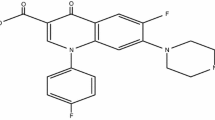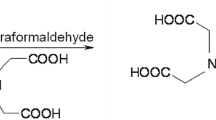Abstract
Sulfadiazine acts through inhibition of bacterial dihydropteroate synthetase. The radio-labeling of sulfadiazine with lutetium-177 (177Lu) is expected to serve as a theranostic agent for deep-seated bacterial infections. The radiosynthesis of 177Lu-sulfadiazine indicated a > 95% yield under optimized reaction conditions, and promising stability was found in blood serum. Biodistribution data in the absence of infection revealed minimal accumulation in key body organs. Kidneys were the main excretory organs, showed an uptake of 1.76 ± 0.09% ID/g organ at 6-h post-injection. Biodistribution, scintigraphic data, glomerular filtration rate, and cytotoxicity results encourage clinical investigation of 177Lu-sulfadiazine as a novel theranostic agent for deep-seated bacterial infection.






Similar content being viewed by others
References
Vranakis I, Goniotakis I, Psaroulaki A, Sandalakis V, Tselentis Y, Gevaert K, Tsiotis G (2014) J Proteom 97:88–99
Kircher M, Lapa C (2017) Curr Cardiovasc Imaging Rep 10:6. doi:10.1007/s12410-017-9400-x
Gandomkar M, Najafi R, Babaei MH, Shafiei M, Sadat Ebrahimi SE (2006) DARU J Pharm Sci 14:183–187
Vinjamuri S, Solanki KK, Bomanji J, Siraj Q, Britton KE, Hall AV, O’Shaughnessy E, Das SS (1996) Lancet 347:233–235
Wareham D, Michael J, Das S (2005) Braz Arch Biol Technol 48:145–152
Liu S, Edwards DS, Barrett JA (1997) Bioconjugate Chem 8:621–636
Akhtar MS, Iqbal J, Khan MA, Irfanullah J, Jehangir M, Khan B, ul-Haq I, Muhammad G, Nadeem MA, Afzal MS, Imran MB (2004) J Nucl Med 45:849–856
Bolzati C, Refosco F, Marchiani A, Ruzza P (2010) Curr Med Chem 17:2656–2683
Ramogida CF, Orvig C (2013) Chem Commun 49:4720–4739
Pillai MRA, Chakraborty S, Das T, Venkatesh M, Ramamoorthy N (2003) Appl Radiat Isot 59:109–118
Cutler CS, Hennkens HM, Sisay N, Huclier-Markai S, Jurisson SS (2013) Chem Rev 113:858–883
Hakimi A, Jalilian AR, Shirvani-Arani S, Abbasian P, Khoshmaram V, Ghannadi-Maragheh M (2015) J Radioanal Nucl Chem 303:1–10
Naseri Z, Hakimi A, Jalilian AR, Nemati Kharat A, Shirvani-Arani S, Bahrami-Samani A, Ghannadi-Maragheh M (2012) Radiochim Acta 100:267–272
Vaidyanathan G, Zalutsky MR (1996) Phys Med Biol 41:1915–1931
Kaltsas GA, Papadogias D, Makras P, Grossman AB (2005) Endocr Relat Cancer 12:683–699
Bergsma H, Konijnenberg MW, van der Zwan WA, Kam BLR, Teunissen JJM, Kooij PP, Mauff KAL, Krenning EP, Kwekkeboom DJ (2016) Eur J Nucl Med Mol Imaging 43:1802–1811
Chakraborty S, Das T, Sarma HD, Venkatesh M, Banerjee S (2008) Nucl Med Biol 35:589–597
Ahmed MT, Naqvi SAR, Rasheed R, Zahoor AF, Usman M, Hussain Z (2017) Appl Biochem Biotechnol. doi:10.1007/s12010-017-2451-2
Levey AS, Greene T, Schluchter MD, Cleary PA, Teschan PE, Lorenz RA, Molitch ME, Mitch WE, Siebert C, Hall PM, Steffes MW (1993) J Am Soc Nephrol 4:1159–1171
Rasheed R, Tariq S, Naqvi SAR, Gillani SJ, Rizvi FA, Sajid M, Rasheed S (2016) J Label Compd Radiopharm 59:398–403
Erion JL, Bugaj JE, Schmidt MA et al (1999) J Nucl Med 40:223
Hens M, Vaidyanathan G, Zhao X-G, Bigner DD, Zalutsky MR (2010) Nucl Med Biol 37:741–750
Motaleb MA, El-Kolaly MT, Ibrahim AB, El-Bary A (2011) J Radioanal Nucl Chem 289:57–65
Vallabhajosula S, Killeen RP, Osborne JR (2010) Semin Nucl Med 40:220–241
Werner J, Dragotakes SC, Fernandez-del Castillo C, Rivera JA, Ou J, Rattner DW, Fischman AJ, Warshaw AL (1998) Ann Surg 227:86–94
Ilem-Ozdemir D, Caglayan-Orumlu O, Asikoglu M, Ozkilic H, Yilmaz F, Hosgor-Limoncu M (2016) J Radioanal Nucl Chem 308:995–1004
Acknowledgements
The study is a part of HEC funded project No.5612/Punjab/NRPU/R&D/HEC/2016, thanks to HEC, GCU Faisalabad, PINSTECH Islamabad and INOR Abbottabad for providing resources, platform, and technical assistance to conduct this research. We are also thankful to Mr. Javid Gil (PINSTECH) for providing technical assistance in handling 177LuCl3. The authors are also grateful to Prof. Drlica Karl (USA) for editing and proof reading of the manuscript.
Author information
Authors and Affiliations
Corresponding author
Ethics declarations
Conflict of interest
There is no conflict of interest exist among all the authors.
Electronic supplementary material
Below is the link to the electronic supplementary material.
Rights and permissions
About this article
Cite this article
Naqvi, S.A.R., Rasheed, R., Ahmed, M.T. et al. Radiosynthesis and preclinical studies of 177Lu-labeled sulfadiazine: a possible theranostic agent for deep-seated bacterial infection. J Radioanal Nucl Chem 314, 1023–1029 (2017). https://doi.org/10.1007/s10967-017-5477-6
Received:
Published:
Issue Date:
DOI: https://doi.org/10.1007/s10967-017-5477-6




